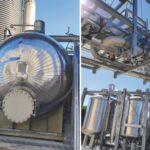REGENERATIVE THERMAL OXIDIZERS Brofind illustrates three examples of solutions based on regenerative purification of industrial emissions, under difficult conditions and with considerable economic advantages.
Brofind, an engineering company with all types of knowhow for reducing the presence of VOCs (volative organic chemicals) in the air, has recently developed a few regenerative process applications for constraining operating conditions. Below are a few promising examples for the converting industry.
Installations with high heat load
There exist various applications (coil coating, laminate production, roto-offset printing among others) in which the temperature of the air released by the production process is very high – between 150 and 300 °C – and the organic load can reach 10 – 12 g/Nm3.
In these industries, then, it is necessary to take stock of the excess buildup of heat, as well as to be able to adjust cycles and temperature levels in order to keep the process balanced, with no undesired extremes.
With a special “hot bypass” that releases part of the excess heat into a flute – directly from the combustion chamber through a heat-resistant valve and special software – it’s possible not only to keep the installation working steadily, but also to optimize possible heat recovery downstream.
Brofind has also executed significant energy recovery systems on many of these installations, producing steam, heating water or thermal fluids, but also supplying customers precious 6 °C chilled water. All this in addition to Energy Efficiency Credits (so-called white certificates), which help to speed the return on an already excellent investment.
The advantage of expanding the spectrum of application of these installations is more evident in sectors characterized by a high degree of variability, which is to say in which production can go from times with low organic load (below self-maintenance concentration) to peaks with a high organic load: here the installation needs to be capable of confronting the opposite problem of high combustion energy, with a consequent rise of heat profiles (photo 1- 2).
 RTO a 2 camere |
 RTO 3 camere da 15000 Nm³h ad alto carico termodinamico. RTO 3 camere da 15000 Nm³h ad alto carico termodinamico. |
 RTO per sostanze organiche clorurate da 20000 Nm³h. RTO per sostanze organiche clorurate da 20000 Nm³h. |
Very dirty gaseous effluents
In certain cases, the production process releases air containing volatile organic chemicals but also many solid compounds, which are difficult to treat with a prefilter because they are so humid, sticky and perhaps at temperatures discouraging wet processes.
In these cases, Brofind has developed a plant layout and, most importantly, a special ceramic material that enables maintaining both a good heat recovery rate and low susceptibility to clogging, at the same time facilitating maintenance operations.
The innovative automatic pyrolisis system called “Burnfind” enables automatic periodic removal of all organic solid compounds deposited on the installation, prolonging intervals between one maintenance operation and the next or eliminating it completely.
Halogenated gases
One of the more complex applications which Brofind has recently studied and implemented has to do with treating halogenated organic chemicals, chlorine and bromine first and foremost.
In this case, the main problems are due to the acids involved and the need to install a post-process to reduce the acids created during combustion. The solution adopted has enabled optimizing all functional parameters of this type of installation, maximizing energy recovery without increasing the risk of corrosion connected with acid condensation. The post-process treatment is performed using a base quench + scrubber section, until the more restricted emission parameters are met (photo 3).
Recovering heat
Regenerative thermal combustion technology was developed in the late 1980s in order to respond to growing demands of eco-sustainability in the polluted air purification sector.
The guiding principle of R&D is to combine environmental legislation orientations with the necessity to contain management costs.
The regeneration process introduces heat recovery to the traditional thermal oxidation of organic contaminants (making carbon dioxide and water, according to the classic chemical reation CxHyOz → CO2 + H2O), with ceramic media specially designed, tested and scaled in order to enable an energy recovery of as much as 96%. In short, the warm polluted air released during the production process is further heated (normally between 750 and 850 °C), then cooled to no more than 30 °C above the initial temperature. The success of this type of installation is due to the fact that the use of external heat, usually supplied by combustible gas, is reduced to a minimum, as well as the so-called “self-maintenance concentration”, beyond which the process no longer requires external fuel, because the heat emitted by the previous combustion supplies all necessary energy (opening photo).
After more than 20 years of experience and hundreds of installations, this process is meeting with more and more popularity, and its applications concern fields until recently considered too “hostile” for renewable energy technologies.













